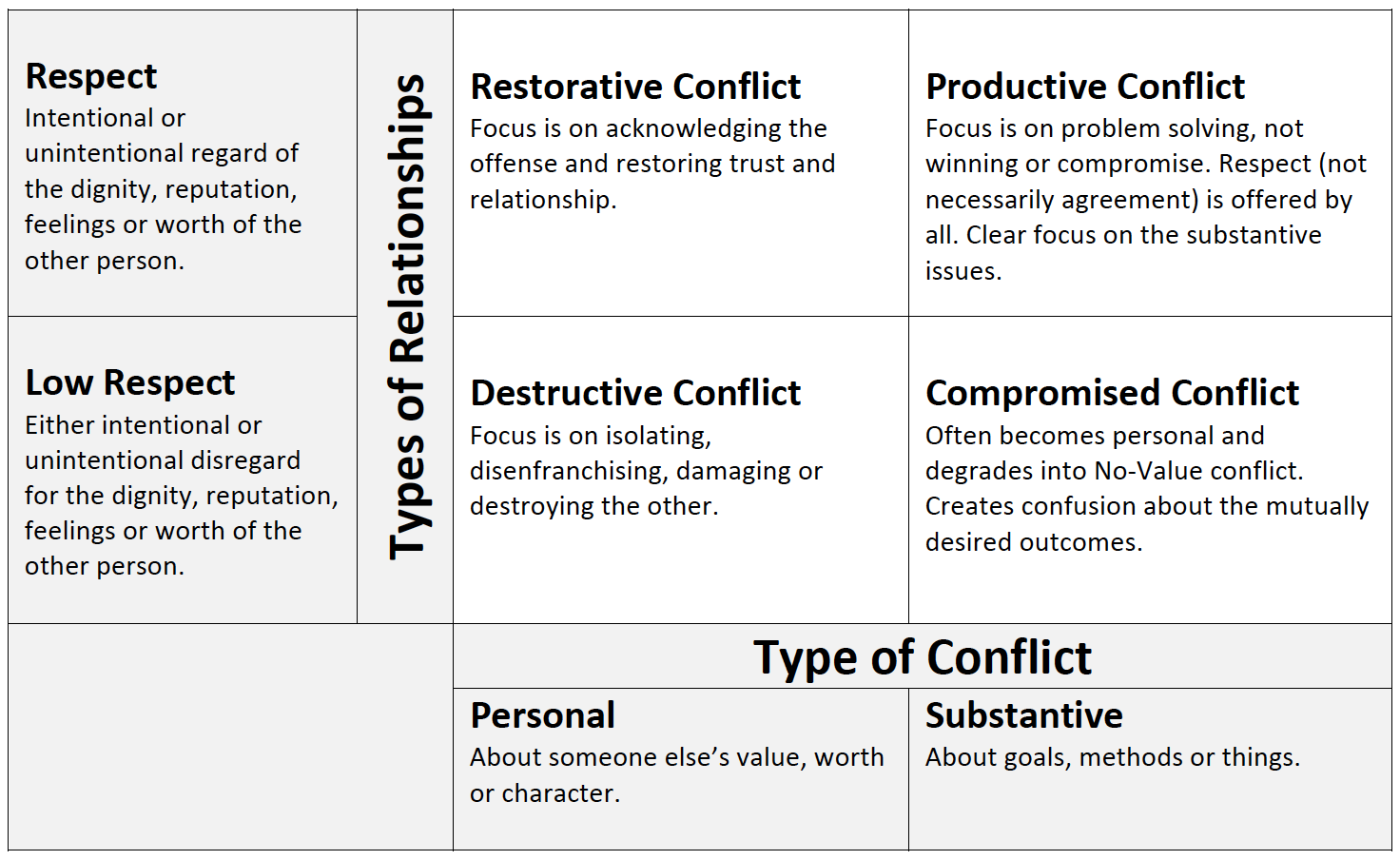The Conflict You Want – And How to Get It

Would you like to radically transform your experience with conflict at work? (Or even at home?) Here is the single most important mindset shift that will set you free regarding conflict:
Not all conflict is equal.
Here is a graphic that helps illustrate this:
- Destructive Conflict (Low Respect/Personal): This is the kind of conflict that is most people’s “worst case scenario.” On a visceral level, this is the most powerful, emotionally charged conflict and tends to shape how we view all other conflict. Because Destructive Conflict is where many conflicts naturally devolve to, we become conditioned to believe that all conflict is personal and disrespectful. Then, for many, the only logical response is to go on the attack or to avoid and/or deny there is an issue.
If you’re trapped in Destructive Conflict, the best way to begin to change the dynamics is to:
- Acknowledge, specifically, how you’ve participated in the problem by not respecting the views, feelings or person you are in conflict with.
- Acknowledge how this has impacted the other person.
- Express your desire to change how you’re relating to the situation.
- Change and offer respect.
Destructive Conflict is difficult to turn around. However, if you’re able to introduce respect and honesty on your side, sometimes the other party will reciprocate. If this happens you’ve been able to elevate to Restorative Conflict.
- Restorative Conflict (High Respect/Personal): People hurt, offend and disregard each other. Sometimes this is intentional. Often times, it is unintentional. Sometimes it’s due to thoughtlessness or a truly un-anticipatable consequence. Regardless of how the offense occurs, when one party reaches out to the other, respectfully and honestly, there is a high chance for restoration. It is very common for the other party to reciprocate, in whole or in part. Because it’s so easy to slide into disrespect, or moments of disrespect, it takes a “strong hand at the wheel” to keep the conversation on-course until resolution has been achieved.
Sometimes, only one party is willing to offer respect. By maintaining this position, you’re often able to prevent further degradation of communication. There’s a strong tendency for people to “match” the behaviors and emotions of others. By staying the course, you can often, but not always, pull the conversation upwards.
Some people who are not familiar with showing respect in conflict may not be able to respond to your respect in the moment. Sometimes giving everyone a defined amount of time to cool down (a minimum of 20 minutes – this allows your body to process adrenaline) can be very helpful.
- Compromised Conflict (Low Respect/Substantive): This is the kind of conflict we often see in politics, on-line discussions, etc. It can often be family conflict over decisions related to finances, vacations, moving, parenting styles, etc. The topics or issues are substantive and neutral. But the conversation feels emotionally charged and, possibly, threatening.
Frequently these are conflicts over methods. Sometimes they are conflicts regarding goals or things. Similar to Destructive Conflict, if one party will start to shift out of the personal approach and begin to intentionally offer respect, listen, and acknowledge personal mistakes, they actually can often step into a leadership role and move the conflict upwards into Productive Conflict.
- Productive Conflict (High Respect/Substantive): This conflict is actually fun. When people feel respected by each other, aren’t afraid to engage on the topics or issues, they can have great conversations that include creative and productive thinking and effective decision-making.
It’s made possible by staying very clear on the substantive issues that are being discussed and then making a point out of building relationships with others based on respect and value where people don’t waste mental or emotional energy on protecting themselves or their ideas. They feel they can trust others to regard them and consider their interests, even if there is disagreement.
Gravity in Conflict
There is strong gravity in conflict. The center of gravity is towards Destructive Conflict (Low Respect/Personal). Just like air and space travel are now commonly accepted and unremarkable methods of transportation, it’s possible to move conflict up towards Restorative and Productive conflict. It’s possible to escape gravity. It just takes focus and effort.
When have you succeeded remaining in Restorative or Productive conflict? What made that possible for you?
When do you tend to get sucked into the “gravitational pull” of Destructive Conflict?
If you would like to schedule a free 30-minute strategy call regarding how you can transform your team and workplace, contact me here.
Article Categories
Popular articles

Download my free 10-page eBook:
How To Accomplish More Without Doing More:
Eight Proven Strategies To Change Your Life
Discover how to save eight hours during your workweek-even if you're too busy to even think about it. The resource every maxed out executive needs.
